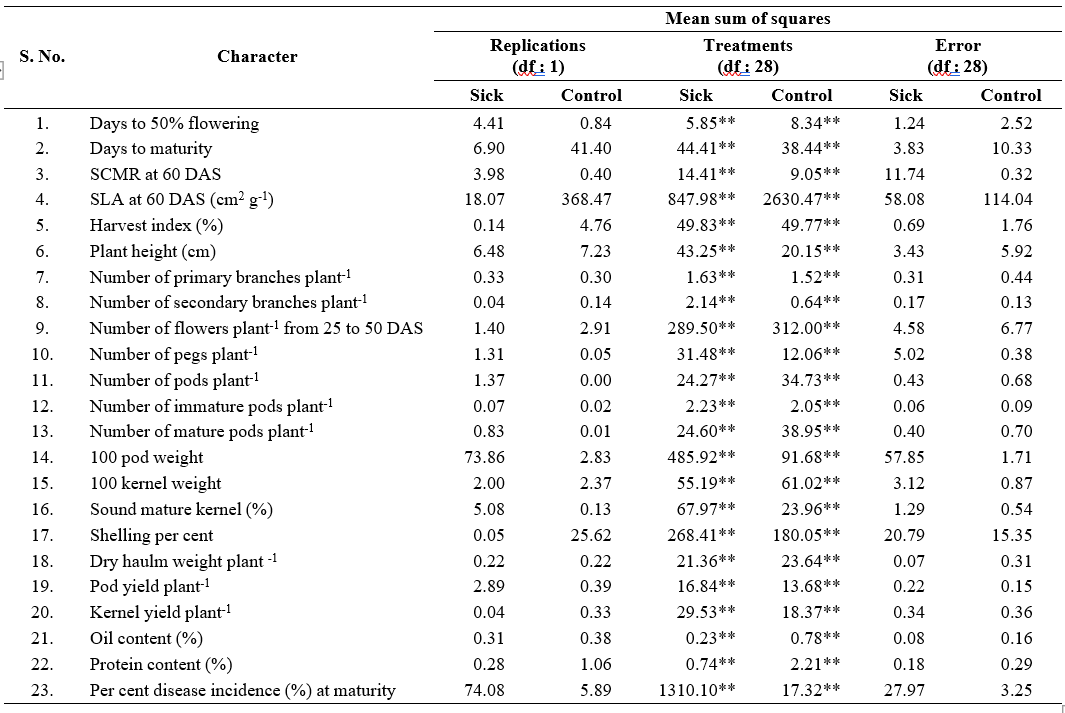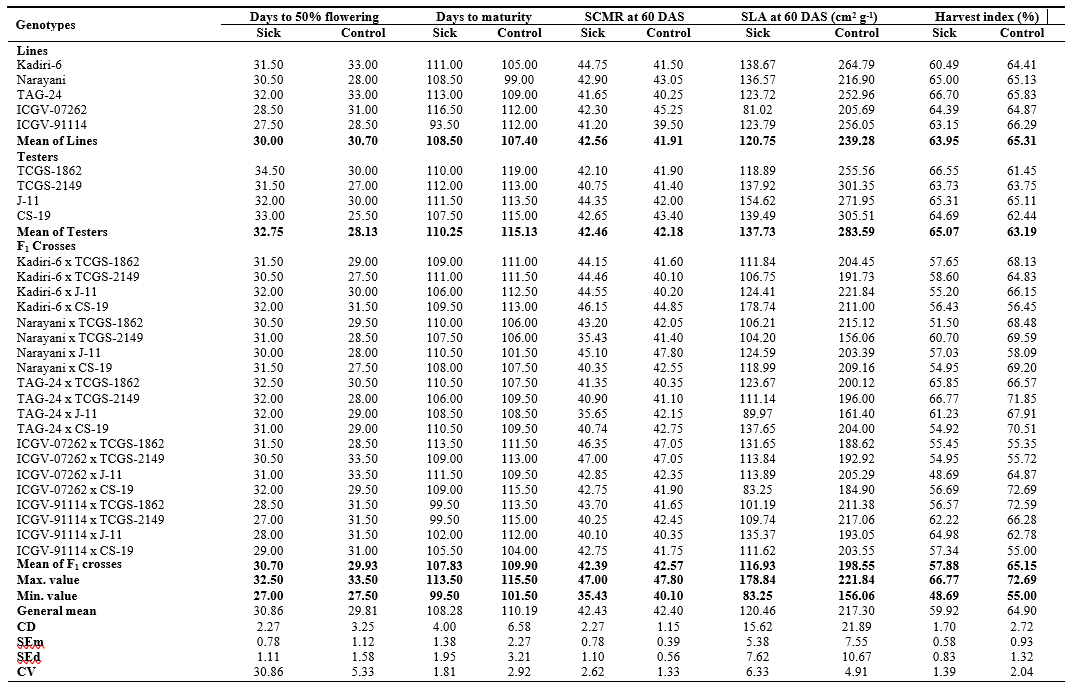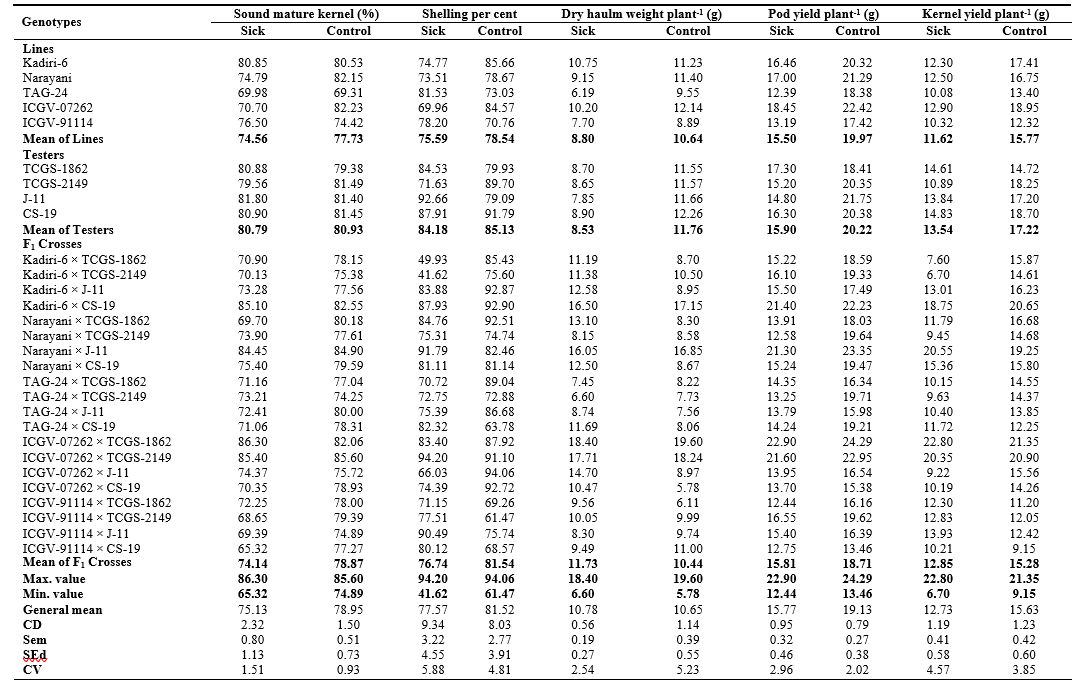Assessment of Parents and F1 Crosses for Yield and Yield Components Under Sick Plot and Control Condition in Groundnut (Arachis Hypogaea L.)
0 Views
K. AMARNATH*, M. REDDISEKHAR, K. JOHN, P. SUDHAKAR AND K. VISWANTH
Department of Genetics and Plant Breeding, S.V. Agricultural College, ANGRAU, Tirupati-517502.
ABSTRACT
In the present investigation, twenty F1 crosses along with nine parents (5 lines and four testers) were evaluated for 23 yield, yield components and stem rot resistance during rabi, 2019 in order to assess the per se performance of parents and crosses under sick plot and control condition. Analysis of variance for all 23 yield, yield components and stem rot resistance revealed that mean sum of squares due to treatments were highly significant for all characters investigated. Among parents, the line ICGV-07262 and tester J-11 and CS-19 were registered as the best performers as they outperformed desirable per se performance for most of the yield and yield components together with stem rot resistance under sick plot and control condition. Hence, these lines and testers could be considered as a potential parent in hybridization for the improvement of groundnut productivity under sick plot and control conditions. The cross ICGV-07262 × TCGS-1862 recorded as superior cross for most of the yield and yield components and could be exploited in breeding programme to develop high pod yielding stem rot resistant genotypes in groundnut.
KEYWORDS: Per se performance, Pod yield, Stem rot resistance, Sick plot, Groundnut.
INTRODUCTION
Groundnut is well known important oilseed crop in the world as well as in India because of its economic importance. The seed is comprised of 40-54 per cent oil, 25-28 per cent protein and 18 per cent of carbohydrates in addition to minerals and vitamins including vitamin E, niacin, phosphorus, falcin, calcium, riboflavin, magnesium, zinc, iron, thiamine, and potassium (Jilbrin et al., 2016).
Glоbаlly, it is сultivаted in аn аreа оf 29.92 Mhа with аnnuаl рrоduсtiоn оf 55.30 Mt and productivity of 1851 kg hа-1 (FAOSTAT, 2021). In Indiа, grоundnut соvers аn аreа оf 60.9 lаkh hа with а рrоduсtiоn оf 10.21 Mt аnd рrоduсtivity оf 1676 kg hа-1. In Аndhrа Рrаdesh, it is сultivаted in аn аreа оf 8.69 lаkh hа with а рrоduсtiоn оf 7.74 Mt аnd рrоduсtivity оf 894 kg hа-1 (Directorate of Economics and Statistics, GOI, 2021). Among the major groundnut growing states of India, Gujarat and Andhra Pradesh are ranking first and second, respectively in terms of area.
Among various biotic stresses limiting groundnut production, stem rot disease caused by soil-borne fungal pathogen Sclerotium rolfsii is predominant, accounting for yield loss to an extent of 10–25 per cent and even upto 80 per cent in severely infected fields annually (Backman and Brenneman, 1997, Rakholia and Jadeja, 2010). Persistence of pathogen in the soil and wide range of host often limits the cultural and chemical control of this disease. The use of resistant varieties is the practical method for the control of stem rot disease. It is evident that stem rot disease has significant effect on yield loss (Pujer et al., 2013). Hence, simultaneous evaluation of groundnut genotypes for pod yield as well as stem rot incidence (%) would be more reliable to develop resistant varieties as well as for their future use in resistance breeding programme.
MATERIAL AND METHODS
The experiment was carried out during rabi- 2019 in sick plot and control condition maintained at Regional Agricultural Research station, Tirupati situated at an altitude of 182.9 m above mean sea level (MSL), 32.27°N latitude and 79.36°E longitude, geographically in southern agro climatic zone of Andhra Pradesh. In sick plot, the crop was artificially inoculated with sclerotium fungus multiplied in sorghum grains between inter rows followed by mulching with paddy straw to entire field after 30 DAS, 60 DAS and irrigation was given frequently through drip pipes to conserve moisture which aggravate the mycelium and aids in further multiplication while all the necessary recommended practices in control condition were followed for maintenance of control condition. The material for the present investigation comprised of nine parents (5 Lines and 4 testers) and their F1s generated through crossing these parents in a Line × Tester mating fashion were grown in a Randomized Block Design and replicated twice. Each entry was grown in two rows of 3 m length and the spacing adopted was 22.5 × 10 cm. Data was recorded in 5 randomly selected plants for pod yield and yield components whereas PDI at Maturity was recorded as per the procedure outlined by Ashok et al. (2004).
At the time of crop maturity, total number of plants per row and number of affected plants in the same row were counted as calculated in the following formula to obtain percent index in terms of percentage.
Per cent disease incidence (%) =

RESULTS AND DISCUSSION
Analysis of Variance
Twenty F1 cross combinations generated from nine parents (Five lines and Four testers) were together evaluated for 23 yield, yield components and stem rot incidence during rabi, 2019 under sick plot and control condition. The analysis of variance for yield, yield components and stem rot resistance was presented in the Table 1.
The analysis of variance revealed highly significant differences among the parents and F1 crosses for all the 23 characters justified the presence of considerable amount of genetic variation for all the traits examined in experimental material comprised of parents and F1s.
Mean Performance of Parents and F1 Crosses
The assessment of the mean performance of genotypes is a key to decide the real field performance. Hence, critical examination of per se performance is the prime factor that determines the fate of breeding program. The mean performance of nine parents (five lines and four testers) and 20 F1 crosses for yield, yield components and stem rot resistance was furnished in the Table 2. The graph depicting the mean performance of the parents and crosses for pod yield plant-1 (g) and PDI at maturity.
The results revealed that line ICGV-91114 attained early flowering (27.50 days) and maturity (93.50 days) in sick plot condition while Narayani was early in flower (28.00 days) and maturity (99.00 days) in control condition, respectively. The tester TCGS-2149 attained early flowering (31.50 days) in sick plot and early maturity (113.00 days) in control condition. Similarly CS-19 was early in flowering (25.50 days) in control condition and attained early maturity (107.50 days) in sick plot condition. Thus, these parents could be exploited to develop short duration varieties with high pod advantage, thereby escaping from drought.
The lines viz., Kadiri-6 in sick plot condition (44.75) and ICGV-07262 in control condition (45.25) recorded higher SCMR at 60 DAS. The line, ICGV-07262 registered desirable least SLA at 60 DAS in sick plot condition (81.02 cm2 g-1) and in control condition (205.69 cm2 g-1). Similarly, TAG-24 in sick plot (66.70%) and 91114 (66.29%) in control condition displayed higher mean performance for harvest index. The tester J-11 displayed high SCMR at 60 DAS in sick plot (44.35) and CS-19 in control condition (43.40) while TCGS-1862 recorded desirable lower SLA at 60 DAS in both sick plot (118.89 cm2 g-1) and control condition (255.56 cm2 g-1). High mean performance for harvest index was displayed in TCGS-1862 (66.55%) in sick plot condition and J-11 in control condition (65.11%). Therefore, these lines and testers could be exploited in breeding programme to develop high pod yielding, water use efficient genotypes.
For plant height, line TAG-24 in sick plot condition (30 cm) and Narayani in control condition (16.25 cm) in control condition while the tester J-11 in sick plot condition (37.60 cm) and TCGS-1862 in control condition (19.30 cm) were identified as shortest genotypes.
In sick plot, the line Kadiri-6 recorded higher per se performance for number of pegs plant-1 (21.55), number of pods plant-1 (20.80), number of mature pods plant-1 (18.20), sound mature kernel % (80.85) and dry haulm weight plant-1 (10.75 g) while it recorded higher mean performance for 100 kernel weight (59.85 g) and shelling per cent (85.66%) in control condition. Similarly, Narayani is identified as the best line as it registered desirable per se performance for plant height (41.50 cm), number of immature pods plant-1 (1.20) and protein content (26.60%) in sick plot condition while it recorded desirable mean for plant height (16.25 cm) and number of pegs plant-1 (9.95) in control condition. Interestingly,
Table 1. Analysis of variance for yield, yield components and stem rot resistance in groundnut

TAG-24 excelled in shelling percent (81.53%) in sick plot condition.
The next superior line ICGV-07262 recorded more mean performance for number of flowers plant-1 (114.50), 100 kernel weight (49.21 g), pod yield plant-1 (18.45 g), kernel yield plant-1 (12.90 g) and oil content (48.40%) in sick plot condition while the same line displayed high mean performance for number of flowers plant-1 (119.00), number of pods plant-1(26.35), number of mature pods plant-1 (24.25), 100 pod weight (126.33 g), SMK % (82.23%), dry haulm weight plant-1 (12.14 g), pod yield plant-1 (22.42 g), kernel yield plant-1 (18.95 g), oil (49.10%) and protein content (27.75%) in control condition.
Line ICGV-91114 outperformed for number of primary branches plant-1 (4.60), number of secondary branches plant-1 (3.65) and 100 pod weight (139.33 g) in sick plot condition while it excelled for number of primary branches plant-1 (6.30), number of secondary branches plant-1 (2.45) and number of immature pods plant-1 (1.75) in desirable direction in control condition.
Among testers, CS-19 recorded higher mean performance for the traits viz., number of flowers plant-1 (114.50), number of pegs plant-1 (22.09), 100 pod weight (129.44 g), dry haulm weight plant-1 (8.90 g) and kernel yield plant-1 (14.83 g) in sick plot condition while the same tester outperformed for plant height (22.50 cm), number of secondary branches plant-1 (2.00), number of flowers plant-1 (117.50), 100 kernel weight (55.10 g), shelling percent (91.79%), dry haulm weight plant-1 (12.26 g) and kernel yield plant-1 (18.70 g) in control condition.
Moreover, the tester TCGS-2149 displayed high mean performance for number of secondary branches plant-1 (3.20), number of pods plant-1 (23.20), number of immature pods plant-1 (1.50), number of mature pods plant-1 (21.70) and 100 kernel weight (55.32 g) in sick plot condition while it outperformed for number of pegs plant-1 (10.85), sound mature kernel % (81.49), oil (48.35%) and protein content (26.85%) in control condition, respectively.
In contrary, J-11 exhibited desirable mean performance for SCMR at 60 DAS (44.35), plant height (37.60 cm), sound mature kernel % (81.80%), shelling per cent (92.66%) and oil content (48.10%) in sick plot condition and it excelled for pod yield plant-1 (21.75 g) in control condition.
The tester TCGS-1862 also registered higher mean performance for harvest index (66.55%), pod yield plant-1 (17.30 g) and protein content (26.25%) whereas in control condition, it exceeded in number of primary branches plant-1 (6.70), number of pods plant-1 (23.30), number of mature pods plant-1 (21.95) and 100 pod weight (125.09 g).
Among F1 crosses, ICGV-91114 × TCGS-2149 attained early flowering (27.00 days) and maturity (99.50 days) in sick plot condition. In contrary, the crosses viz., Kadiri-6 × TCGS-2149 and Narayani × CS-19 flowered earlier (27.50 days) while Narayani x J-11 matured early (101.50 days) in control condition. Besides, Narayani × J-11 is found to record more number of pegs plant-1 (27.57) in sick plot condition while it also registered high SCMR at 60 DAS (47.80) and oil content (49.50%) in control condition.
On the other hand, ICGV-07262 × TCGS-2149 outperformed in SCMR at 60 DAS (47.00) and shelling per cent (94.20%) in sick plot condition while the same cross exceeded in mean performance for number of pods plant-1 (33.20), number of mature pods plant-1 (30.65) and SMK% (85.60) in control condition.
Another best cross, Kadiri-6 × CS-19 displayed higher mean performance for number of secondary branches plant-1 (4.10), number of immature pods plant-1 (1.09), number of mature pods plant-1 (22.21) and recorded desirable lowest PDI at maturity (11.82%) in sick plot condition. The same cross also outperformed for the traits viz., number of secondary branches plant-1 (2.90), number of pegs plant-1 (15.45), 100 pod weight (136.65 g), 100 kernel weight (61.35 g) and protein content (27.40%) in control condition.
However, the cross ICGV-07262 × TCGS-1862 reported higher mean performance for number of primary branches plant-1 (6.50), number of secondary branches plant-1 (1.00), number of pods plant-1 (24.76), sound mature kernel % (86.30%), dry haulm weight plant-1 (18.40 g), pod yield plant-1 (22.90 g) and kernel yield plant-1 (22.80 g) in sick plot condition. In addition, the same cross registered higher mean performance for dry haulm weight plant-1 (19.60 g), pod yield plant-1 (24.29 g) and kernel yield plant-1 (21.35 g) in control condition.
Table 2. Mean performance of nine parents and 20 F1 crosses for yield, yield components and stem rot resistance in groundnut





From the above premise, it was concluded that among lines, ICGV-07262 was identified as superior as it registered for most of the yield and yield attributing traits in both sick plot and control condition while the testers viz., CS-19 and J-11 in sick plot condition and CS- 19 and TCGS-2149 in control condition were identified as best performers for yield and yield components. The cross ICGV-07262 x TCGS-1862 is identified as the outstanding cross for pod and kernel yield plant-1 in both sick plot and control condition.
ACKNOWLEDGEMENTS
The author wish to acknowledge Ministry of Tribal Affairs (MoTA) for granting National Fellowship for scheduled Tribes (NFST) to the first author in the form financial assistance during Doctoral research work.
LITERATURE CITED
Ashok, J., Fakrudin, B., Paramesh, H., Kenchanagoudar,
P.V and Kullaiswamy, B.Y. 2004. Identification of groundnut (Arachis hypogaea L.) germplasm resistant to stem and pod rot caused by Sclerotium rolfsii Saac. Indian Journal of Genetics. 64(3): 247: 248.
Backman, P.A and Brenneman, T.B. 1997. Stem rot. Compendium of Peanut Diseases. 36-37.
Directorate of Economics and Statistics, Department of Agriculture, Cooperation and Farmers Welfare, Ministry of Agriculture and Farmers Welfare, GOI. 2021. Agricultural Statistics at a Glance. 56-58.
FAOSTAT, 2021. Food and Agriculture Organization of the United Nations. World Agricultural Production, Rome, Italy. http://faostat.fao.org/.
Jibrin, M., Habu, S., Echekwu, C., Abdullahi, U and Usman, I. 2016. Phenotypic and genotypic variance and heritability estimates for oil content and other agronomic traits in groundnut (Arachis hypogaea L.). International Journal of Scientific Research and Engineering Studies. 6(3): 29-32.
Pujer, S.B., Kenchanagoudar, P.V., Gowda, M.V.C and Channayya, H. 2013. Genetic parameters and association analysis for resistance to Sclerotium rolfsii Sacc. in groundnut (Arachis hypogaea L.). Indian Journal of Plant Genetic Resources. 26: 155-161.
Rakholia, K.B and Jadeja, K.B. 2010. Varietal screening of groundnut against stem and pod rot (Sclerotium rolfsii). International Journal of Plant Protection. 3(2): 398-399.
- Genetic Divergence Studies for Yield and Its Component Traits in Groundnut (Arachis Hypogaea L.)
- Correlation and Path Coefficient Analysis Among Early Clones Of Sugarcane (Saccharum Spp.)
- Character Association and Path Coefficient Analysis in Tomato (Solanum Lycopersicum L.)
- Survey on the Incidence of Sesame Leafhopper and Phyllody in Major Growing Districts of Southern Zone of Andhra Pradesh, India
- Effect of Organic Manures, Chemical and Biofertilizers on Potassium Use Efficiency in Groundnut
- A Study on Growth Pattern of Red Chilli in India and Andhra Pradesh

